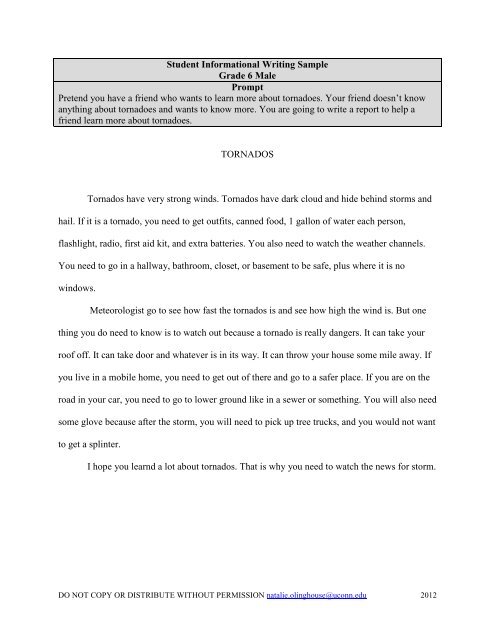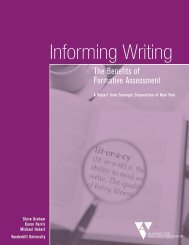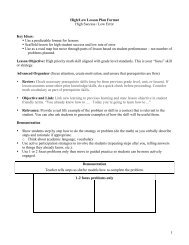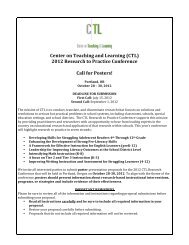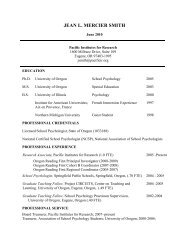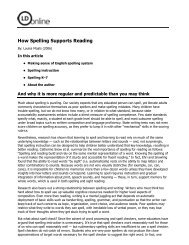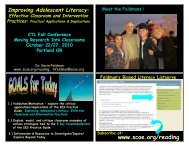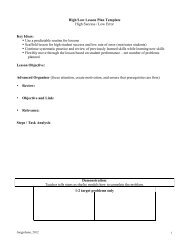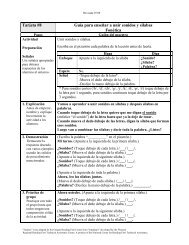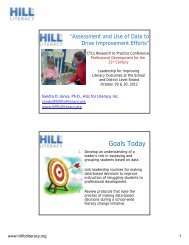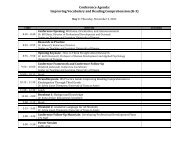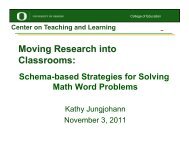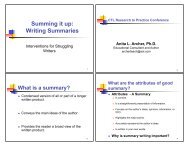Olinghouse Writing Assessment Resource Handouts
Olinghouse Writing Assessment Resource Handouts
Olinghouse Writing Assessment Resource Handouts
You also want an ePaper? Increase the reach of your titles
YUMPU automatically turns print PDFs into web optimized ePapers that Google loves.
Student Informational <strong>Writing</strong> SampleGrade 6 MalePromptPretend you have a friend who wants to learn more about tornadoes. Your friend doesn’t knowanything about tornadoes and wants to know more. You are going to write a report to help afriend learn more about tornadoes.TORNADOSTornados have very strong winds. Tornados have dark cloud and hide behind storms andhail. If it is a tornado, you need to get outfits, canned food, 1 gallon of water each person,flashlight, radio, first aid kit, and extra batteries. You also need to watch the weather channels.You need to go in a hallway, bathroom, closet, or basement to be safe, plus where it is nowindows.Meteorologist go to see how fast the tornados is and see how high the wind is. But onething you do need to know is to watch out because a tornado is really dangers. It can take yourroof off. It can take door and whatever is in its way. It can throw your house some mile away. Ifyou live in a mobile home, you need to get out of there and go to a safer place. If you are on theroad in your car, you need to go to lower ground like in a sewer or something. You will also needsome glove because after the storm, you will need to pick up tree trucks, and you would not wantto get a splinter.I hope you learnd a lot about tornados. That is why you need to watch the news for storm.DO NOT COPY OR DISTRIBUTE WITHOUT PERMISSION natalie.olinghouse@uconn.edu 2012
2011 NAEP <strong>Writing</strong> <strong>Assessment</strong>Preliminary Holistic Scoring Guide for To ExplainAvailable at http://www.nagb.org/content/nagb/assets/documents/publications/frameworks/writing-2011.pdfScore = 6 Responses in this range demonstrate effective skill in responding to the writing task. Allelements of the response are well controlled and effectively support the writer’s purpose, audience,and form.• The response provides a thoughtful and insightful explanation of the subject by fully examiningthe topic as a whole, by identifying and fully discussing significant parts of the subject, and/or byevaluating and fully discussing the importance of the parts.• The explanation maintains an effective balance between broad assertions and well-chosen generaland specific details and examples to fully support understanding. Approaches to the developmentof ideas (e.g., analyzing, evaluating, narrating, etc.) are used skillfully to support the clarity of theexplanation.• Ideas are clearly focused on the topic throughout the response. Organization demonstrates alogical, well-executed progression of ideas that supports the clarity of the explanation and isrelevant to the writer’s approaches to organization (e.g., summarizing, narrating, etc.). Transitionseffectively convey relationships among ideas.• Sentence structure is well controlled and varied to communicate relationships among ideas. Wordchoice is specific, precise, and evaluative and supports the clarity of the explanation. Voice andtone are well controlled and effective for the writer’s purpose and audience.• Though there may be a few minor errors in grammar, usage, and mechanics, meaning is clearthroughout the response.Score = 5 Responses in this range demonstrate competent skill in responding to the writing task.Elements are usually well controlled and clearly support the writer’s purpose, audience, and form.• The response provides a clear explanation of the subject by examining the topic as a whole,identifying and discussing various parts of the subject, and/or by evaluating and discussing theimportance of those parts.• The explanation usually maintains an effective balance between broad assertions and general andspecific details and examples to support the clarity of the explanation. Approaches to thedevelopment of ideas are usually used skillfully to support the clarity of the explanation.• Ideas are usually focused on the topic. Organization is clear and may demonstrate a logicalprogression of ideas that supports the clarity of the explanation and is relevant to the writer’sapproaches to organization. Transitions clearly convey relationships among ideas.• Sentence structure is well controlled to communicate relationships among ideas and varied asappropriate for the writer’s purpose. Word choice is usually specific and precise, and it usuallysupports the clarity of the explanation. Voice and tone are usually controlled and effective for thewriter’s purpose and audience.• Grammar, usage, and mechanics are usually correct with a few distracting errors, but meaning isclear.
Score = 4 Responses in this range demonstrate adequate skill in responding to the writing task.Most elements are controlled and support the writer’s purpose, audience, and form.• The response provides an explanation by addressing most parts of the subject and may include anevaluation of the importance of some of these parts.• The explanation maintains an adequate balance between broad assertions and specific examplesand details. While details and examples adequately support the clarity of the explanation, theirdevelopment may be somewhat uneven. Approaches to the development of ideas are adequate,but their relevance to the explanation may not always be clear.• Ideas are usually focused on the topic and an organizational structure is evident. Ideas arelogically grouped and adequately reflect the writer’s use of relevant approaches to organization.Relationships among ideas are mostly clear.• Sentence structure is adequately controlled and somewhat varied to communicate relationshipsamong ideas. Word choice is sometimes specific and adequately supports the clarity of theexplanation. Voice and tone are mostly controlled and usually effective for the writer’s purposeand audience.• Grammar, usage, and mechanics are mostly correct with some distracting errors, but meaning isclear.Score = 3 Responses in this range demonstrate developing skill in responding to the writing task.Some elements are controlled and provide some support for the writer’s purpose, audience, andform.• The response provides some explanation of the subject.• The explanation may provide both broad assertions and general and specific examples, but thebalance may be uneven and only somewhat controlled. Some relevant details and examples areused, but they are not developed enough to support the explanation, or they may be unevenlydeveloped. Approaches to the development of ideas are evident, but they may not be clearlyrelevant to the explanation.• Most ideas are focused on the topic. The response uses a simple organizational structure, and forthe most part, ideas are logically grouped. There may be some evidence of approaches toorganization, but they may not be clearly relevant, or they may be confusing. Relationshipsamong ideas are sometimes unclear.• Sentence structure is usually correct and there may be a little sentence variety to communicaterelationships among ideas. Word choice is usually clear and sometimes specific, but at times itmay not be appropriate for the writer’s purpose. Voice and tone show some understanding ofwhat is appropriate for the writer’s purpose and audience.• Grammar, usage, and mechanics are mostly correct but with some distracting errors that mayoccasionally impede understanding.
Score = 2 Responses in this range demonstrate marginal skill in responding to the writing task.Elements are sometimes controlled but provide weak support for the writer’s purpose, audience,and form.• The response provides a little explanation of the subject.• A balance between broad assertions and general and specific examples may not be evident. Ifdetails and examples are present, they are brief, general, or inadequately developed, and they maynot be clearly relevant to the explanation. There may be minimal evidence of relevant approachesto the development of ideas.• Some ideas may not be clearly focused on the topic. The response shows an attempt to organizethoughts by grouping ideas, and there may be minimal evidence of approaches to organization.However, relationships among ideas are often illogical or unclear.• Sentence structure is sometimes correct, but there is little, if any, sentence variety. Word choice israrely specific and does little to support the clarity of the explanation. Voice and tone show littleunderstanding of what is appropriate for the writer’s purpose and audience.• Grammar, usage, and mechanics are usually correct but with many distracting errors that impedeunderstanding.Score = 1 Responses in this range demonstrate little or no skill in responding to the writing task.Elements are seldom controlled and provide almost no support for the writer’s purpose, audience,and form.• The response may provide little or no explanation of the subject.• If any details or examples are present, they are brief, general, undeveloped, or not relevant to theexplanation.• The response shows an attempt to organize thoughts by grouping ideas, but groupings areillogical and there is little or no evidence of relevant approaches to organization. Relationshipsamong ideas are mostly unclear.• Sentence structure is often incorrect; word choice is often unclear and inappropriate; and there islittle or no control of appropriate voice and tone.• Grammar, usage, and mechanics are sometimes correct but with frequent distracting errors thatoften impede understanding.• The response may be too brief to support a sound judgment about the development of ideas,organization, or language facility and conventions.Score = 0 Unscorable: Response is too brief to score; not written in English; off topic; orillegible.
6+1 Traits® Condensed 5-Point 3-12 Writer’s Rubric aka One PagerIdeas: The main message of the piece, thetheme, with supporting details that enrich anddevelop that theme. This paper is clear and focused. It holds thereader's attention. Relevant anecdotes and detailsenrich the central theme.A. The topic is narrow and manageableB. Relevant, telling, quality details go beyond theobviousC. Ideas are crystal clear and supported with detailsD. <strong>Writing</strong> from knowledge or experience; ideas arefresh and originalE. Reader's questions are anticipated and answered.F. Insightful topic The writer is beginning to define the topic, eventhough development is still basic or general.A. The topic is broadB. Support is attemptedC. Ideas are reasonably clearD. Writer has difficulty going from generalobservations about topic to specificsE. The reader is left with questionsF. The writer generally stays on topic The paper has no clear sense of purpose orcentral theme. The reader must make inferencesbased on sketchy or missing details.A. The writer is still in search of a topicB. Information is limited or unclear or the length is notadequate for developmentC. The idea is a simple restatement or a simpleanswer to the questionD. The writer has not begun to define the topicE. Everything seems as important as everything elseF. The topic may be repetitious, disconnected, andcontains too many random thoughtsKey Question: Did the writer stay focused and shareoriginal and fresh information or perspective about thetopic?Organization: The internal structure, thread ofcentral meaning, logical and sometimes intriguingpattern or sequence of the ideas. The organizational structure of this paperenhances and showcases the central idea or themeof the paper; includes a catchy introduction and asatisfying conclusion.A. An inviting introduction draws the reader in; asatisfying conclusion leaves the reader with asense of closure and resolution.B. Thoughtful transitions connect ideas.C. Sequencing is logical and effective.D. Pacing is well controlled.E. The title, if desired, is original.F. Organizational structure is appropriate for purposeand audience; paragraphing is effective. The organizational structure is strong enough tomove the reader through the text without too muchconfusion.A. The paper has a recognizable introduction andconclusion.B. Transitions sometimes work.C. Sequencing shows some logic, yet structure takesattention away from the content.D. Pacing is fairly well controlled.E. A title, if desired, is present.F. Organizational structure sometimes supports themain point or story line, with an attempt atparagraphing. The writing lacks a clear sense of direction.A. No real lead or conclusion present.B. Connections between ideas, if present, areconfusing.C. Sequencing needs work.D. Pacing feels awkward.E. No title is present (if requested).F. Problems with organizational structure make it hardfor the reader to get a grip on the main point orstory line. Little or no evidence of paragraphingpresent.Key Question: Does the organizational structureenhance the ideas and make it easier to understand?Voice: The unique perspective of the writer evidentin the piece through the use of compelling ideas,engaging language, and revealing details. The writer of this paper speaks directly to thereader in a manner that is individual, compelling,engaging, and shows respect for the audience.A. Uses topic, details, and language to strongly connectwith the audience.B. Purpose is reflected by content and arrangement ofideas.C. The writer takes a risk with revealing details.D. Expository or persuasive reflects understanding andcommitment to topic.E. Narrative writing is honest, personal, and engaging. The writer seems sincere, but not fully engaged orinvolved. The result is pleasant or even personable,but not compelling.A. Attempt to connect with audience is earnest butimpersonal.B. Attempts to include content and arrangement of ideasto reflect purpose.C. Occasionally reveals personal details, but avoids risk.D. Expository or persuasive writing lacks consistentengagement with the topic.E. Narrative writing reflects limited individualperspective. The writer seems uninvolved with the topic and theaudience.A. Fails to connect with the audience.B. Purpose is unclear.C. <strong>Writing</strong> is risk free, with no sense of the writer.D. Expository or persuasive writing is mechanical,showing no engagement with the topic.E. Narrative writing lacks development of a point ofview.Key Question: Would you keep reading this piece if itwere longer?© 2010, Education Northwest Page 1
6+1 Traits® Condensed 5-Point 3-12 Writer’s Rubric aka One PagerWord Choice: The use of rich, colorful, andprecise language that moves and enlightens thereader. Words convey the intended message in aprecise, interesting, and natural way.A. Words are specific and accurate.B. Striking words and phrases create imagery.C. Natural, effective and appropriate language.D. Lively verbs, specific nouns and modifiers.E. Language enhances and clarifies meaning.F. Precision is obvious by choice of words andphrases. The language is functional, even if it lacks muchenergy.A. Words are adequate and correct in a generalsense.B. Familiar words and phrases communicate.C. Attempts at colorful language.D. Passive verbs, everyday nouns, mundanemodifiersE. Language functions, with one or two finemoments.F. Occasionally, the words and phrases showrefinement and precision The writer struggles with a limited vocabularyA. Words are nonspecific or distracting.B. Many of the words don’t work.C. Language is used incorrectly.D. Limited vocabulary, misuse of parts of speech.E. Language is unimaginative and lifeless.F. Jargon or clichés, persistent redundancy.Sentence Fluency: The rhythm and flow of thelanguage, the sound of word patterns, the way inwhich the writing plays to the ear, not just to theeye. The writing has an easy flow, rhythm andcadence. Sentences are well constructed.A. Sentences enhance the meaning.B. Sentences vary in length as well as structure.C. Purposeful and varied sentence beginnings.D. Creative and appropriate connectives.E. The writing has cadence. The text hums along with a steady beat, buttends to be more pleasant or businesslike thanmusical.A. Sentences get the job done in a routine fashion.B. Sentences are usually of similar length, yetconstructed correctly.C. Sentence beginnings are sometimes varied.D. The reader sometimes has to hunt for connectiveclues.E. Parts of the text invite expressive oral reading;other parts may be stiff, awkward, choppy, organgly. The reader has to practice quite a bit in order togive this paper a fair interpretive reading.A. Sentences are choppy, incomplete, rambling, orawkward. Phrasing does not sound natural.B. No "sentence sense" present.C. Sentences begin the same way.D. Endless connectives, if any present.E. <strong>Writing</strong> does not invite expressive oral reading.*Conventions: The mechanical correctness ofthe piece; spelling, punctuation, capitalization,grammar usage, and paragraphing. The writer demonstrates a good grasp ofstandard writing conventions (e.g., spelling,punctuation, capitalization, grammar usage,paragraphing)A. Spelling is generally correct.B. Punctuation is accurate.C. Capitalization skills are present.D. Grammar and usage are correct.E. Paragraphing tends to be sound.F. The writer may manipulate and/or edit for stylisticeffect; and it works! The writer shows reasonable control over alimited range of standard writing conventionsA. Spelling is usually correct or reasonably phoneticon common words.B. End punctuation is usually correct.C. Most capitalized words are correct.D. Problems with grammar and usage are not serious.E. Paragraphing is attempted.F. Moderate, inconsistent editing (a little of this, a littleof that). Errors in spelling, punctuation, capitalization,usage and grammar and/or paragraphing repeatedlydistract the reader and make text difficult to read.A. Spelling errors are frequent.B. Punctuation missing or incorrect.C. Capitalization is random.D. Errors in grammar or usage are very noticeable.E. Paragraphing is missing.F. Little, if any, editing; the reader must read once todecode, then again for meaning.Key Question: Do the words and phrases create vividpictures and linger in your mind?Key Question: Can you FEEL the words and phrasesflow together as you read it aloud?Key Question: How much editing would have to bedone to be ready to share with an outside source? A whole lot? Score in the 1-2 range. A moderate amount? Score in the 3 range. Very little? Score in the 4-5 range.*Expectations for Conventions should be based on grade level and include only those skills that have actually been taught.© 2010, Education Northwest Page 2
Primary Trait—Informative RubricScoreCriteriaTITLE0 No title is given1 A title is given, but it is vague2 The title is given and is well suited to the storyTHESIS/TOPIC STATEMENT0 There is no thesis statement1 The thesis statement generally presents the topic of the composition.The thesis statement presents a more detailed description of the2composition topic.CONTEXT0 The introduction does not include any context.1 The introduction provides a general context for the composition.The introduction includes specific details regarding the context of the2composition.MAIN IDEAS0 There are no main ideas or the ideas presented are unrelated to the topic1 The essay is a list of unelaborated ideas related to the thesis statementThere is 1 main idea related to the topic statement that has at least one2elaboration.2 or more main ideas related to the topic statement that have at least one3elaboration.ELABORATION (DETAILS)A detail = When? Where? Who? Why? What? How?0 There are no elaborations.1 There is one elaboration per main idea.2 There are two elaborations for one main idea.There are three or more elaborations for one main idea.3 ORThere are two or more elaborations for two or more main ideas.CONCLUSION0 There is no conclusionThere is a general concluding statement and/or minimal concluding1section that wraps up the composition.The concluding statement is specific to the ideas presented in the2composition and/or a concluding section that wraps up the composition.DO NOT COPY OR DISTRIBUTE WITHOUT PERMISSION natalie.olinghouse@uconn.edu 2012
Paragraph ScoringElement Paragraph 1 Paragraph 2 Paragraph 3Is the paragraph indented? □yes □no □yes □no □yes □noIs there a simple sentence?□yes □no □yes □no □yes □no___Number of simple sentences___Number of correct simple sentencesIs there a compound sentence?□yes □no □yes □no □yes □no___Number of compound sentences___Number of correct compound sentencesIs there a complex sentence?□yes □no □yes □no □yes □no___Number of complex sentences___Number of correct complex sentencesIs the paragraph all on one topic? □yes □no □yes □no □yes □noIs there a topic sentence? □yes □no □yes □no □yes □no1. Is there a main idea?Does it relate to the topic sentence?a. Is there a detail?Does it relate to the main idea?□yes □no□yes □no□yes □no□yes □no□yes □no□yes □no□yes □no□yes □no□yes □no□yes □no□yes □no□yes □no2. Is there a main idea?Does it relate to the topic sentence?a. Is there a detail?Does it relate to the main idea?□yes □no□yes □no□yes □no□yes □no□yes □no□yes □no□yes □no□yes □no□yes □no□yes □no□yes □no□yes □no3. Is there a main idea?Does it relate to the topic sentence?a. Is there a detail?Does it relate to the main idea?□yes □no□yes □no□yes □no□yes □no□yes □no□yes □no□yes □no□yes □no□yes □no□yes □no□yes □no□yes □noDO NOT COPY OR DISTRIBUTE WITHOUT PERMISSION natalie.olinghouse@uconn.edu 2012
Sentence Component <strong>Assessment</strong>Sentence ComponentsRating ScaleUses correct prefixes and word endings 0 1 2 3 4Uses internal punctuation correctly 0 1 2 3 4Uses capital letters correctly 0 1 2 3 4Maintains verb tense 0 1 2 3 4Uses pronouns correctly 0 1 2 3 4Maintains subject–verb agreement 0 1 2 3 4Writes complete sentences 0 1 2 3 4Writes sentences with varied lengths and structures 0 1 2 3 40 = not present in composition1 = all incorrect2 = several incorrect with a few correct3 = several correct with a few incorrect4 = all correctDO NOT COPY OR DISTRIBUTE WITHOUT PERMISSION natalie.olinghouse@uconn.edu 2012


